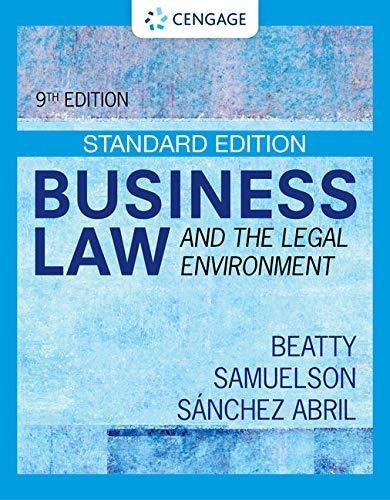Question
Chong wants you to learn to cite quoted text from court opinions. She gives you notes to review and practice exercises to complete. Here are
Chong wants you to learn to cite quoted text from court opinions. She gives you notes to review and practice exercises to complete. Here are her notes:
When we quote or paraphrase text from court opinions, our citations need to identify the page number(s) where the quoted material can be found. These are called pinpoint citations. Here's an example:
On the other hand, "evidence establishing beyond a reasonable doubt a connection of a defendant with the conspiracy, even though the connection is slight, is sufficient to convict him with knowing participation in the conspiracy." United States v. Dunn, 564 F.2d 348, 357 (9th Cir. 1977).
Notice that:
The quoted text consists of fewer than fifty words, and it is enclosed within quotation marks.
The citation is placed immediately after the quote.
The pinpoint page (357) appears immediately after the start page number.
Here is a longer quotation. It requires a different format because of its length.
Where the terms and manner of employment are disputed and different inferences may be drawn therefrom, the issue as to the relation that existed between the parties is a mixed question of law and fact, to be determined by the trier of the facts, under proper instructions, . . . but where the essential terms and manner of employment are undisputed, the question is one of law for the Court.
Clayburn v. Soueid, Inc., 211 A.2d at 731.
Notice that:
The quoted text consists of fifty or more words; therefore, it appears as an indented block quotation (blockquote). Quotation marks are not used. (See BB Rule 5.1; IB Rule 40.)
The citation is placed on a separate line after the quote; unlike the quoted text, it is not indented.
The citation has the names of the parties, the volume #, the reporter abbreviation and the page on which the quote is located. The start page, deciding court, and year of the decision are missing, however. This is a short form citation. (See BB Rule 10.9 or IB Rule 15.) In some circumstances, short forms can be used if you have provided the full citation previously in the document.
Instructions
Using Westlaw, find the excerpts from the court opinions described below. Quote and cite each excerpt. Each answer should include both the text being quoted and a pinpoint citation to the regional reporter (A.2d) in correct Bluebook format. (Do not cite the official reporter, alone or as part of a parallel citation.) Do not use a short form UNLESS specifically requested.
Citation Exercises
1. Quote and cite this text from Deering Woods Condominium Association v. Margaret F. Spoon, an opinion located at 377 Md. 250.
Further, even if we were to decide that the waiver of claim bylaw provision is inapplicable or unenforceable and remand to the circuit court as to Condo and Mgmt. Co., Ms. Spoon would still face the defense of lack of constructive notice, after remand, in the circuit court. The circuit court unambiguously decided the notice issue favorably to the defendants Mgmt. Co. and CA and effectively has decided it as to Condo.
2. Quote and, using a short form, cite this text, which is also from Deering Woods Condominium Association, 377 Md. 250. Assume that you already provided a full citation and need to cite the opinion again after citing other cases. Use a short form.
In the instant matter, although the circuit court did not articulate its reasons when it formally granted CA's motion, the only defense argued by CA was the lack of constructive notice.
3. Quote and cite this text from Chandra Maans v. Giant of Maryland, L.L.C., an opinion located at 161 Md. App. 620.
Appellant cites no Maryland authority supporting the aforementioned ipse dixit, and we know of none. The duty of a store owner to an invitee, such as appellant, is well established in Maryland, as can be seen by the cases cited supra.
4. Quote and cite this text from Michael Singer Joseph v. Bozzuto Management Company et al., an opinion located at 173 Md. App. 305.
It is a truism that a violation of a statute or regulation cannot operate to excuse a knowledge requirement if proof of the violation itself requires the satisfaction of the knowledge requirement. If the plaintiff must prove at the front end of his thesis the very thing he seeks to be exempted from proving at the tail end of his thesis, the argument is gibberish.
Step by Step Solution
There are 3 Steps involved in it
Step: 1

Get Instant Access to Expert-Tailored Solutions
See step-by-step solutions with expert insights and AI powered tools for academic success
Step: 2

Step: 3

Ace Your Homework with AI
Get the answers you need in no time with our AI-driven, step-by-step assistance
Get Started


